Table of Contents
Profit and loss are fundamental concepts that we frequently come across in everyday language. Whenever a transaction takes place, individuals often assess whether it resulted in a profit or a loss. When we purchase products, we instinctively evaluate the gain or loss associated with the transaction.
Understanding the key terms related to Profit and Loss is essential, especially for aspirants preparing for competitive exams. These exams often feature questions on this topic, and a clear grasp of the concepts can make solving these questions straightforward; otherwise, they might become time-consuming. In this article, we cover the basic terms, formulas, concepts, tricks, questions, and examples related to profit and loss.
Profit & Loss For Bank Exams
Profit & Loss is one of the favorite topics of the examiner which is commonly asked in the banking examinations. Profit & Loss is asked in the prelims as well as the mains exam with a difference in the difficulty level. Instead of doing it again & again, clear your concepts once and then practice profit & loss questions. Most of the candidates make a mistake by directly jumping on the short tricks instead of learning the core concepts therefore we will provide all the formulas of profit & loss and also try to clear your concepts. Keep reading this article to check profit & loss questions & examples.
Profit and Loss: Basic Terms
Here we have provided below some of the basic formulas of profit & loss which will help you in solving questions quickly.
Cost Price
The price at which an article is purchased is called its cost price (C.P.)
Selling Price
The price at which the article is sold is called its selling price (S.P.)
Profit
When the selling price is more than the cost price then it is called profit
Loss
When the selling price is less than the cost price then it is called loss
Marked Price or List Price (MP or LP) and Discount
Marked price is the price that is marked on the product or that is quoted in the price list. It is the price at which the product is quoted or intended to be sold. However, the seller can decide to give discounts to the buyer and the actual selling price might be different from the marked price. Given that there is no discount, the marked price is the same as the selling price.
The amount of discount given will always be calculated on the marked price. This can be expressed as Discount Percent= MP-SP/MP×100
Profit Loss: Formulas
- Profit/Gain = Selling Price – Cost Price
- Loss = Cost Price – Selling Price
- Cost Price = Selling Price ( No profit No loss)
- Gain Percentage = (Gain × 100)/(C.P.)
- Loss Percentage = (Loss × 100)/(C.P.)
Profit and Loss: Tricks
Well, tricks are nothing but a way to reduce the steps to calculate the answer, if you know the basics then only you can understand the logic behind the tricks. So we have provided below some profit & loss tricks that you can use while solving similar types of questions
- Profit, P = SP – CP; SP>CP
- Loss, L = CP – SP; CP>SP
- P% = (P/CP) x 100
- L% = (L/CP) x 100
- SP = {(100 + P%)/100} x CP
- SP = {(100 – L%)/100} x CP
- CP = {100/(100 + P%)} x SP
- CP = {100/(100 – L%)} x SP
- Discount = MP – SP
- SP = MP -Discount
- When two different articles are sold at the same selling price getting a gain of x% on the first and a loss of x% on the second, then the overall loss in the transaction is given by (x/10)² %. (Note: In such questions, there is always a loss.)
- A merchant uses faulty measures and sells his goods at a gain/loss of x%. The overall % gain/loss(g) is given by (100+g)/(100+x)=(True measure)/(Faulty measure). (Note: If the merchant sells his goods at cost price, then x = 0.)
- A merchant uses y% less weight/length and sells his goods at gain/loss of x%. The overall % gain/loss is given by [((y+x)/(100-y))×100]%
Profit & Loss: Dishonest Dealer Concept
Dishonest Dealers and faulty weights are important topics in profit and loss generally asked in all competitive exams. In this topic, we come across such types of problems in which the shopkeeper sells the items at a cost price but still, he makes a profit on those items. This can be only possible if he gives less quantity to the customer than the indicated on the product. A dishonest merchant shows he is selling the product at a cost price for the welfare of the customer but in that, he reduced its weight.
For example, if a shopkeeper sells a 1-liter packet of milk at its cost price but he gives only 800 ml of milk in that packet. In this case, he is giving 800 ml of milk to a customer and charging an amount of 1000 ml to the customer. Hence, we can say that 800 ml is the cost price and 1000 ml is the selling price. So, he is getting a profit of 200 ml of milk on selling 800 ml of milk.
Percentage profit = ((Selling Price – Cost Price)/(Cost Price))×100
Percentage profit = ((1000-800)/800)×100 = 25%
Profit and Loss: Questions
Q1. What will be the single discount equivalent to two successive discounts of 25% and 24%?
(a) 46%
(b) 43%
(c) 40%
(d) 33%
(e) 49%
Q2. I bought 16 pencils at the rate of Rs 9 per dozen and sold all of them at the rate of Rs 12 per dozen. What is the overall profit percentage in this transaction?

Q3. A seller marks up an article 160% above of its cost price. After it he allows two successive discount of 20% and 25% and yet he gets 56% profit on it. If marked price of article is Rs 520 then find its selling price
(a) Rs 320
(b) Rs 312
(c) Rs 240
(d) Rs 324
(e) Rs 230
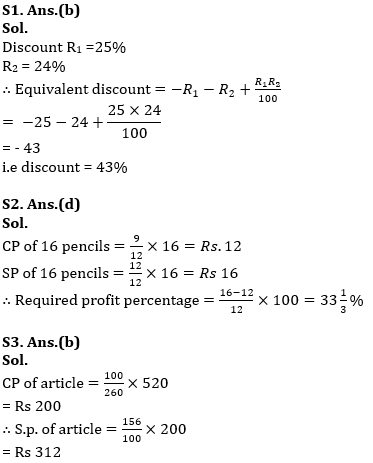
Q4. A milkman buys some milk. If he sells it at Rs 5 per litre, he loses Rs 300, but when he sells it at Rs 6 per litre, he gains Rs 250. How much milk did he purchase?
(a) 550 lt
(b) 300 lt
(c) 250 lt
(d) 800 lt
(e) 650 lt
Q5. A trader sells two articles for Rs. 4,800 each, neither losing nor gaining in total. If he sold one of the articles at a gain of 20%, the other is sold at a loss of what percent?
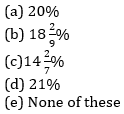
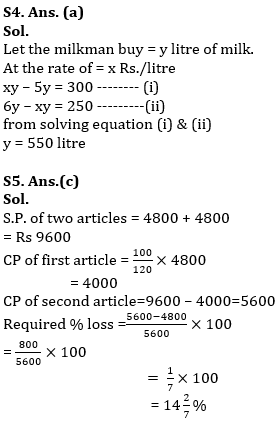
Q6. How many kg of tea worth Rs. 25 per kg must be blended with 30 kg of tea worth Rs. 30 per kg so that by selling the blended variety at Rs. 30 per kg there should be gain of 10%?
(a) 30 kg
(b) 32 kg
(c) 36 kg
(d) 42 kg
(e) 34 kg
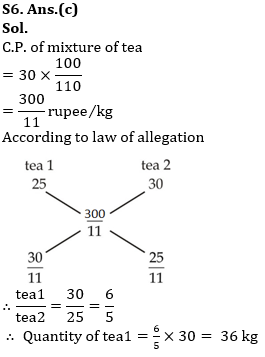
Q7. The price of a product after getting 10% discount is Rs.9450 which includes 5% tax on selling price. Find the marked price of the product (in Rs)?
(a) 8500
(b) 9000
(c) 10000
(d) 9500
(e) 10500
Q8. A shopkeeper in place of selling a article at 10% profit, mark up the article 30% above cost price and gives a discount of 10%. In this process he gets Rs. 56 more profit. Find the cost price of article.
(a) Rs. 400
(b) Rs. 1000
(c) Rs. 800
(d) Rs. 600
(e) Rs. 500
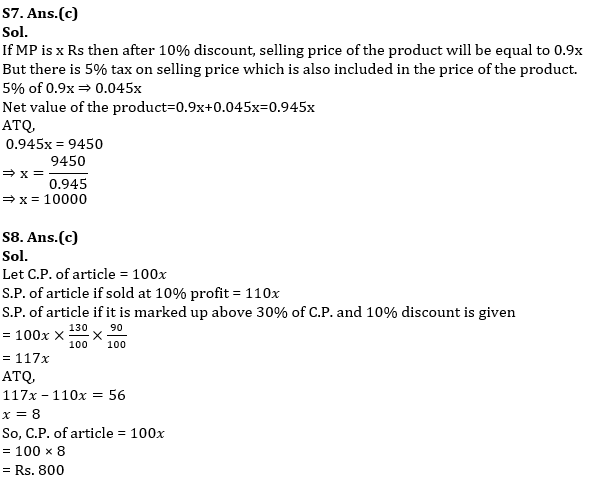
Q9. A person purchases four bicycles at a discount of 20% on marked price on each bicycle. If sum of discount offered and profit obtained on all 4 bicycles is 2560 then find the difference in marked price and cost price on one bicycle.
(a) 520
(b) 640
(c) 1220
(d) 880
(e) 690
Q10. Veer buy an article for Rs. 480. He sold it at 12% loss and get some money and from that money he again buys an article and this he sold at 25% profit. What was profit percentage he got from this transaction?
(a) 16%
(b) 12%
(c) 10%
(d) 14%
(e) 20%
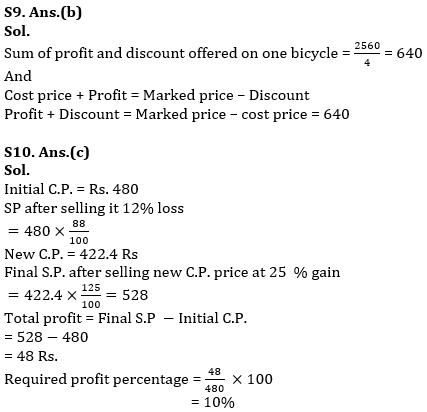

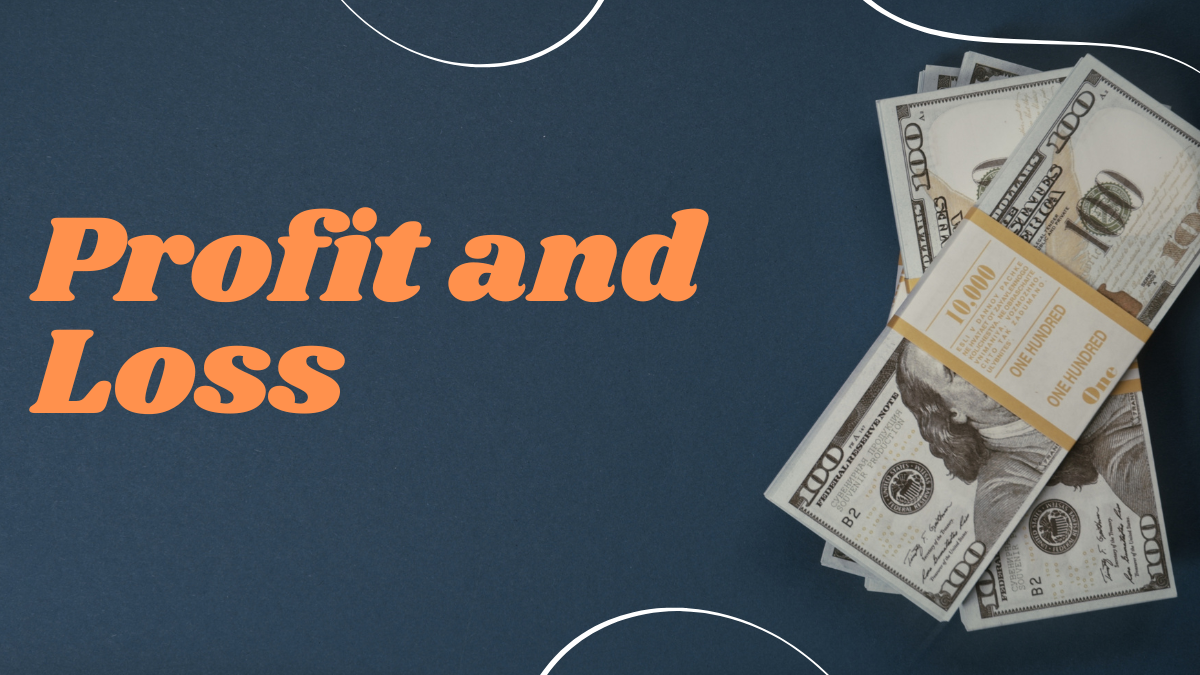


 GA Capsule for SBI Clerk Mains 2025, Dow...
GA Capsule for SBI Clerk Mains 2025, Dow...
 The Hindu Review October 2022: Download ...
The Hindu Review October 2022: Download ...
 Banking, Economy Capsule for SBI PO Main...
Banking, Economy Capsule for SBI PO Main...





